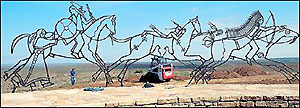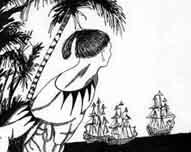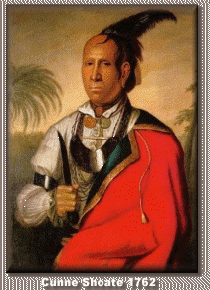| (insert your NIE or newspaper logo here) |
Weekly Online LessonOnline Lesson ArchiveGrade Level: 6-12
|
European Expansion in America
 Wednesday,
June 25, 2003, marked the anniversary of when Lt. Col. George A. Custer
and the 7th Cavalry attacked an Indian encampment along the Little Bighorn
River in what's now southeastern Montana.
Wednesday,
June 25, 2003, marked the anniversary of when Lt. Col. George A. Custer
and the 7th Cavalry attacked an Indian encampment along the Little Bighorn
River in what's now southeastern Montana.
What was expected to be an easy victory for Custer and his forces turned out to be a devastating clash. Apparently, Custer had underestimated the number of Cheyenne and Arapaho warriors ready to fight back. In the end, about 260 cavalrymen, including Custer and his Indian scouts, had died. The Indians were estimated to have lost fewer than 100.
Since then, a granite obelisk and white headstones have been erected to honor the fallen cavalrymen at this historic site, located on the Crow Indian Reservation. And, finally, 127 years after celebrating their victorious battle, a memorial now stands to honor the Indian warriors who also fought and lost their lives there.
Wednesday's dedication ceremony of the memorial — a wiry sculpture of Indian warriors, a sunken stone circle (a sacred symbol to many tribes), and an area for tribal ceremonies — drew hundreds of Sioux, Cheyenne and Arapaho tribal members as well as non-Indian tourists.
The memorial not only honors the individual warriors and their tribes who took part in this particular battle, however. Some also believe it's one more significant step in recognizing and discussing the history of this country from more than one viewpoint.
So for this week's lesson, you'll explore human settlement in America — from the 1500s to about the turn of the 20th Century. You'll follow the relationships and changes beginning in the east, then you'll head west to witness the final battles of this era.
First Contact
 First you'll need to get a glimpse of the people who were already here
when the Europeans began to arrive. To begin, visit with the Early
Americans to learn about how the different regional tribes
lived, from the Atlantic to the Pacific. Clicking on the any of the
active underlined words will take you to other websites for more information
about those topics.
First you'll need to get a glimpse of the people who were already here
when the Europeans began to arrive. To begin, visit with the Early
Americans to learn about how the different regional tribes
lived, from the Atlantic to the Pacific. Clicking on the any of the
active underlined words will take you to other websites for more information
about those topics.
Start with the Eastern Woodland Indians, then browse through the other groups — Plains Indians, Northwest Indians, California-Intermountain Indians and the Southwest Indians.
Which tribes lived in each region? How did their local environments influence how they lived, including housing arrangements, food sources, clothing, etc.? How did neighboring tribes treat each other?
Christopher Columbus may be remembered as the European who "discovered" America in 1492, but he never made it as far north as present-day Florida. It wasn't until 1540 that Spaniard Hernando de Soto and his crew first landed on that peninsula's western shoreline. From there, they traveled to the area of South Carolina, over to Illinois and all the way down into Texas. That same year, Francisco Vazquez de Coronado explored the continent from Cuba through Mexico, New Mexico and as far east as Kansas.
These in-depth expeditions by the Spanish Conquistadors stirred up the people who lived there, and jump-started a series of battles for dominance across the continent. Visit Skyhawk's page to read an overview of these Indian Wars. What kinds of things happened when Europeans and their descendents spread into Indian country in these different regions? How were their relationships different under different regional circumstances? How did the relationships and interactions change over time?
In the East
 Your
time travel journey starts in the east with Hernando de Soto (also written
as "DeSoto") and the Native
American Conquest at American History for Teens site. Read
page 1 and page
2, and also check out the map of the Conquest
Trails thru America and What
happened to the Indians?
Your
time travel journey starts in the east with Hernando de Soto (also written
as "DeSoto") and the Native
American Conquest at American History for Teens site. Read
page 1 and page
2, and also check out the map of the Conquest
Trails thru America and What
happened to the Indians?
Why did DeSoto come to North America? What challenges did he face and how did he fare? How did the ways in which the Indians lived influence how modern inhabitants live in these regions?
Now flip to the other side and take an extended tour of this era through the History of the Cherokee. Under First Contact with Europeans, read Fire in the Mountains as an introduction to this Indian nation. Then browse the other pages of the section (you can also use the NEXT button on each page): First European Contact, Initial Contacts with English Colonists, and 1700 Through the Revolutionary War.
How did contact with the Spanish affect the Indians? How was that different from their relations with the colonists at first? How did relationships change as the colonists expanded their foothold on the continent? What actions or emotions incited physical conflict between these groups of people?
For a further study into the Cherokee viewpoint, from the History of the Cherokee visit the pages titled, The Chickamauga, The Arkansas Cherokee, and The Trail of Tears: Samuel's Memory, and the Historical Maps of Cherokee Country. What happened when the Cherokee began moving West? How do you think the Indians felt about getting pushed off their homelands?
In the West
 In
1803, the federal government made the Louisiana Purchase and had Meriwether
Lewis and William Clark map the young nation's new land holdings. Although
Lewis and Clark's journey began in 1803, it was until the 1860s —
when the American Civil War ended — that mass migration across
the Plains to the Pacific Coast occurred. Many people were drawn westward
by the promise of homesteads and discoveries of gold.
In
1803, the federal government made the Louisiana Purchase and had Meriwether
Lewis and William Clark map the young nation's new land holdings. Although
Lewis and Clark's journey began in 1803, it was until the 1860s —
when the American Civil War ended — that mass migration across
the Plains to the Pacific Coast occurred. Many people were drawn westward
by the promise of homesteads and discoveries of gold.
And when that happened, clashes between new settlers and Indian inhabitants became more frequent and escalated into more violent conflicts.
To take a look at what transpired in this region, visit EyeWitness: The Old West. Begin your journey in 1865 by Crossing the Plains. How was traveling and living in the West different from where the migrants had come from?
During the last quarter of the 19th Century, Indians and U.S. soldiers and civilians fought some of the biggest battles during the European expansion era. Learn about three of the biggest battles through the Eyewitness pages: Battle with the Apache, 1872, Battle of the Little Bighorn, 1876, and Massacre at Wounded Knee, 1890.
Also read the Battle of Little Bighorn eyewitness account of Lakota Chief Red Horse, presented by PBS. The biography of another chief, Chief Joseph of the Nez Perce, offers further insight into how tribal members lived and died during their last days of freedom before being moved to reservations by the federal government.
So, in looking at the big picture, how did population growth and European culture influence expansion and development of the U.S.? How did a person's heritage shape his or her perspective about these conflicts? What exactly were the Indian tribes, new migrants and the U.S. government fighting over? Why do you think the results turned out as they did? How do you feel about these events and how they've shaped our history as a nation?
Newspaper Activities
In a current issue of Targetnewspaper, find stories related to Indian history in your region or somewhere else in North America. Maybe some archeologists dug up some new Indian artifacts, for example, or maybe there's an event at a nearby historical battlefield or a new museum exhibit featuring Indian culture. To which tribe does the news event relate? How does the news contribute to our understanding of American history — locally, regionally and nationally? How do different groups of your community feel about this news and why?
© Copyright 2003
Learners Online, Inc.
